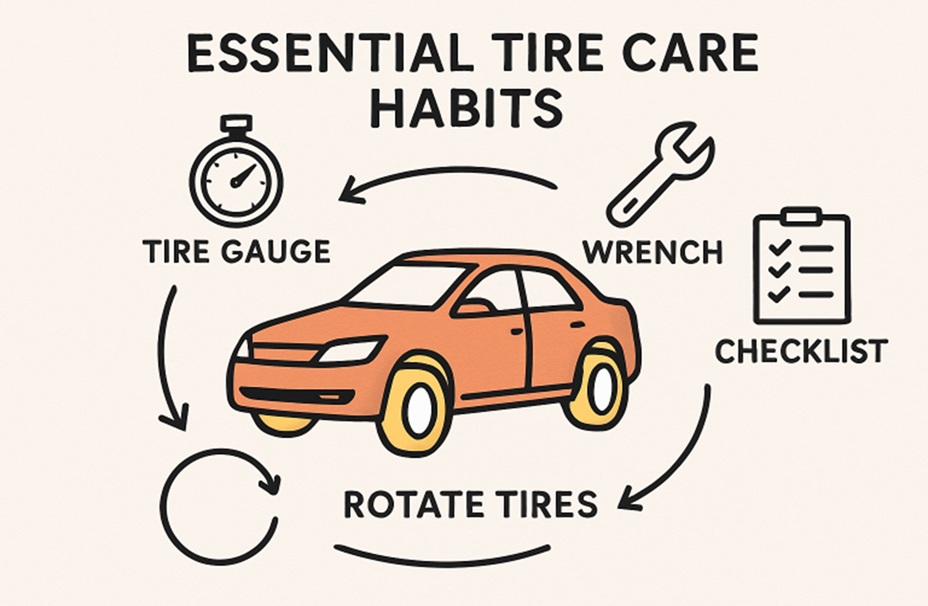Maintaining your vehicle’s tires is vital for protecting your investment and ensuring safety. Regular tire care boosts fuel efficiency, safety, and driving comfort. Many drivers rely on professional services for routine maintenance to stay road-ready. Key steps like maintaining proper tire pressure and scheduled inspections can extend tire life and improve handling, reducing the risk of failure and costly repairs. Following proactive maintenance benefits your tires and vehicle overall. Simple habits can significantly enhance tire health and performance. Choosing a trusted auto shop with tire expertise further prolongs tire life. Keeping tires at the recommended pressure is crucial; underinflation causes excess wear and lowers fuel economy, while overinflation leads to center wear and handling issues. Check tire pressure monthly when tires are cold for best accuracy.
Rotate Your Tires at Recommended Intervals
Periodic tire rotation is essential for achieving even tread wear. Since front and rear tires perform different tasks—front tires generally take on more stress from steering and braking—they tend to wear at different rates. Rotating your tires every 5,000 to 7,500 miles, or as your vehicle’s manufacturer recommends, helps ensure all tires wear evenly. Pairing this practice with routine auto repair services can notably extend tire lifespan, improve performance, and keep your drive smooth and quiet.
Ensure Proper Wheel Alignment and Balancing
Proper wheel alignment is critical for even tire wear and optimal vehicle handling. Misalignment can be caused by hitting curbs, potholes, or regular driving over time. An alignment check is needed to see if you notice your vehicle pulling to one side or feel vibrations at certain speeds. Wheel balancing is equally essential; even the slightest imbalance can cause uneven wear and uncomfortable vibration. Aim to have your alignment and balancing checked annually or whenever you experience these symptoms.
Practice Safe and Smooth Driving Habits
How you drive has a direct impact on tire wear. Rapid acceleration, harsh braking, and aggressive cornering generate excessive heat and friction, quickly wearing down tire treads. Pairing smoother driving habits with routine visits to an auto repair shop ensures your tires remain in optimal condition, reducing premature wear and improving overall performance.
Avoid Overloading Your Vehicle
Overloading your vehicle increases the stress on your tires, leading to overheating, premature wear, and a heightened risk of blowouts. Always adhere to the vehicle’s prescribed load limits, usually found inside the driver’s door or in the owner’s manual. Carrying only necessary items and avoiding excessive cargo helps preserve tire structure and ensures a safer ride.
Regularly Inspect Your Tires for Damage
Frequent visual inspections can catch early signs of trouble, such as punctures, cuts, bulges, or embedded debris. Checking tread depth is equally vital—tires with insufficient tread can’t grip the road, especially in wet or icy conditions. A quick way to test is with the penny test: insert a penny into the tread with Lincoln’s head down; if you can see the top of his head, it’s time for replacement. Addressing minor issues before they escalate can save you from unexpected, costly repairs and accidents.
Store Tires Properly When Not in Use
Tires not in active use, such as seasonal spares, must be stored correctly to avoid damage and degradation. Even if unused, exposure to direct sunlight, high temperatures, or humid environments can prematurely age tires. Store tires in a cool, dry place and keep them off the ground with racks or shelves. If they must be stacked, avoid stacking them too high to prevent deformation. These steps preserve rubber integrity and ensure the tires are ready when needed.
Conclusion
Effective tire maintenance is much more than an occasional check or service—it’s a set of consistent habits that can add thousands of miles to your tire’s life and help maintain your vehicle’s safety and performance. You reduce the likelihood of costly roadside issues by checking tire pressure, rotating tires, ensuring proper alignment, and driving with care. Couple these habits with help from reputable professionals, and you’ll enjoy a safer, more efficient driving experience for years.


